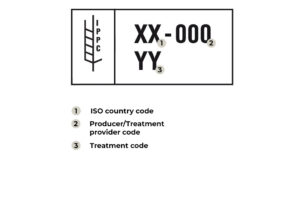
Historically, international trade has focused on an issue that should not be underestimated: the insidious spread of harmful organisms, viruses and bacteria through goods, contaminated by these elements not visible to the naked eye. The issue has become even more delicate with globalisation, which has further intensified contacts between countries, and has not spared any sector, not even the wood industry: pallets and packaging can in fact be a vehicle for organisms that are potentially dangerous to the integrity of foreign forests and crops, or even to human health.
In order to nip the risk in the bud, without having to interrupt the lucrative trade flow, the United Nations, through the International Plant Protection Convention (IPPC) acted firmly at the beginning of the millennium by promulgating ISPM15 (International Standards for Phytosanitary Measures no. 15), which resolves the issue by indicating the sanitising treatment to which the wood must be subjected before shipment: a process that has drying as its fundamental cornerstone.
What is the ISPM15 FAO Standard and which Countries are Involved
The ISPM15 standard is a regulation of phytosanitary measures to be applied to raw wood packaging, which aims to reduce the spread of harmful organisms from one continent to another. To achieve this goal, wooden materials and containers must first undergo specific treatments, particularly heat treatments, and then be marked with an indelible mark that makes them immediately recognisable (each country has its own version of the IPPC/FAO mark and the Italian version of this standard is the FITOK certification): only under these conditions can a wood pallet or packaging be included in international goods traffic.
The standard, approved in 2002 and based on the principle of voluntary adherence, was originally subscribed to by 118 countries, including the United States and its main trading partners, including Italy (by subscription, we mean that states agree to the standard, but without the constraint of making it mandatory in their national regulations). In the course of its history, it has undergone three revisions (2006, 2009 and 2013) and to date there are more than 70 countries that necessarily require the marking:
- Europe: Russian Federation, Norway, Portugal, Serbia, Turkey, Ukraine.
- North and Central America: Canada, Channel Islands, Costa Rica, Cuba, District of Columbia, Jamaica, Guam, Guatemala, Honduras, Northern Mariana Islands, Virgin Islands, Mexico, Nicaragua, Panama, Puerto Rico, Dominican Republic, American Samoa, United States, Trinidad and Tobago.
- South America: Argentina, Bolivia, Brazil, Chile, Colombia, Ecuador, Guyana, Paraguay, Peru, Uruguay, Venezuela.
- Asia: Saudi Arabia, China, Philippines, Japan, Jordan, India, Indonesia, Israel,
Korea, Lebanon, Malaysia, Oman, Republic of Georgia, Seychelles, Syria, Singapore, Sri Lanka, Taiwan, Thailand, Vietnam. - Africa: Algeria, Ivory Coast, Egypt, Kenya, Lesotho, Malawi, Nigeria, Senegal, South Africa, Tunisia.
- Oceania: Australia, New Zealand, French Polynesia, Samoa.
Among EU members, the use of packaging treated according to the ISPM15 standard is not mandatory, with the exception of packaging from Portugal.
The suitability of pallets and packaging according to the standard
Let us now enter the more technical meanderings of the standard, and see what pre-shipment treatment consists of in detail and how pallets and packaging are actually regulated. In order to eliminate any harmful organisms from wood, ISPM15 indicates to proceed with a thermal action. However, this assumption has changed over the years: at one time, fumigation was used, i.e. a treatment that affected the pallets by means of methyl bromide, which was made illegal in the EU since 2010 due to the toxicity of this gas. In more recent times, therefore, it has been replaced by the HT treatment (high temperature), which consists of subjecting the wood core of pallets and packaging to a temperature of 56° in specific kilns for 30 minutes: in this way, they reach a degree of purification that allows them to be shipped across the continent, without affecting the environments for which they are intended.
After the HT treatment, which actually lasts half an hour, but is part of a cycle whose duration can range from 6 to 10 hours depending on the season (after all, the temperature, in order not to split the wood, must be brought up to speed gradually and clearly takes less time in summer), the indelible suitability marking can be applied. This is structured as follows: next to the IPPC ear of wheat logo are the country code, the region code and the manufacturer’s code, which stand out against the abbreviation HT, which testifies to the high-temperature treatment. Only if these two elements (HT treatment and certification) coexist can pallets and packaging be exported beyond the borders of the European Union.

Why wood drying is essential to comply with the protocol
Simply put, drying is the process by which moisture is removed from wood. This purifies and sterilises it, making it suitable for the uses for which it is intended on a daily basis. This includes international trade: for what is HT treatment if not a partial drying process that removes harmful organisms from pallets and wooden packaging? It cannot be defined as complete, because the HT process does not remove 100% moisture (the drying process takes much longer in terms of time: just think that to obtain a wood moisture content of 18%, it is necessary to leave the material in the drying kiln for 36/72 hours), but in any case, it takes place according to the principles of drying, which is therefore a fundamental process to fall within the parameters established by the ISPM15 protocol. And it does not matter if it does not completely remove residual moisture: the standard gives no indication of the final water content of the wood.
